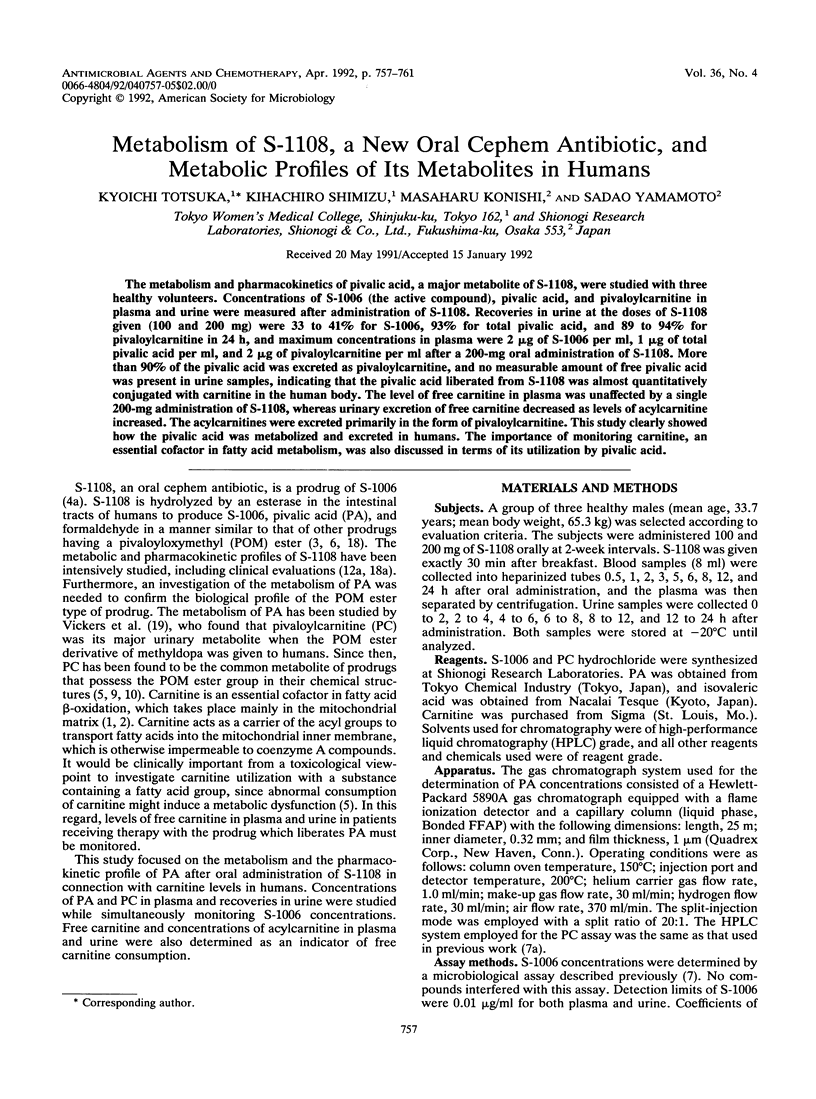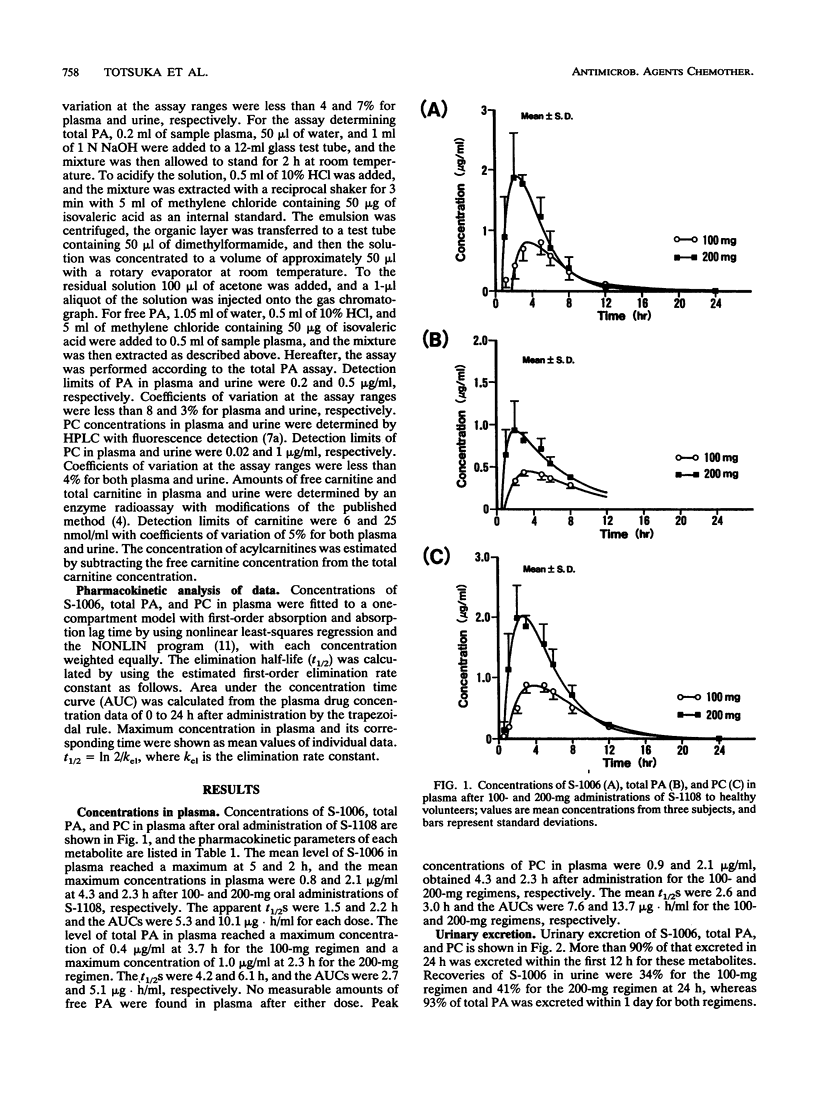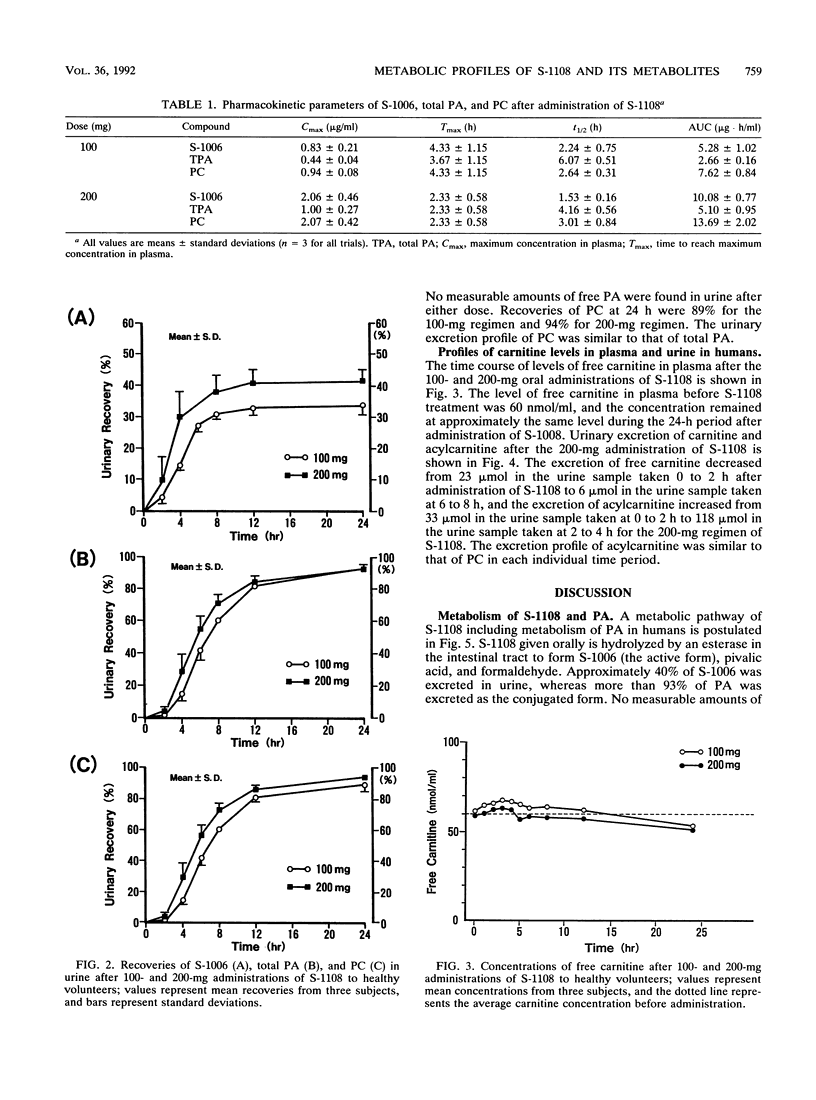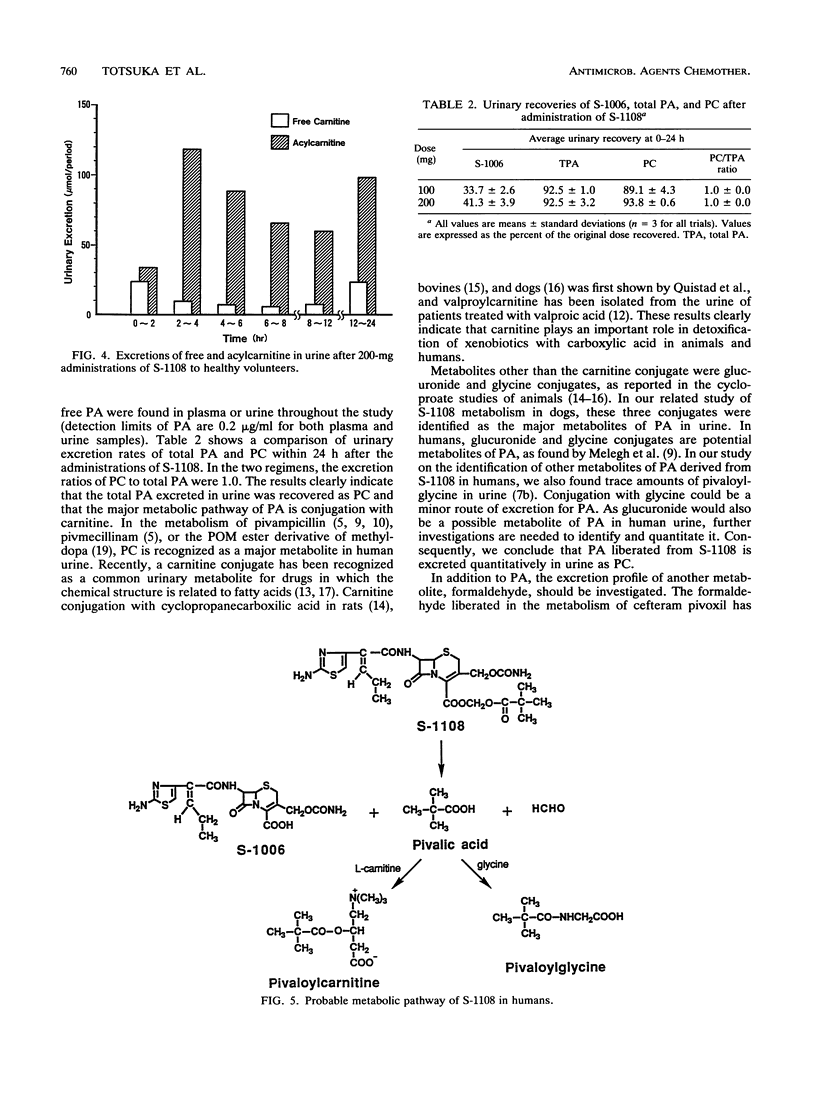Abstract
The metabolism and pharmacokinetics of pivalic acid, a major metabolite of S-1108, were studied with three healthy volunteers. Concentrations of S-1006 (the active compound), pivalic acid, and pivaloylcarnitine in plasma and urine were measured after administration of S-1108. Recoveries in urine at the doses of S-1108 given (100 and 200 mg) were 33 to 41% for S-1006, 93% for total pivalic acid, and 89 to 94% for pivaloylcarnitine in 24 h, and maximum concentrations in plasma were 2 micrograms of S-1006 per ml, 1 micrograms of total pivalic acid per ml, and 2 micrograms of pivaloylcarnitine per ml after a 200-mg oral administration of S-1108. More than 90% of the pivalic acid was excreted as pivaloylcarnitine, and no measurable amount of free pivalic acid was present in urine samples, indicating that the pivalic acid liberated from S-1108 was almost quantitatively conjugated with carnitine in the human body. The level of free carnitine in plasma was unaffected by a single 200-mg administration of S-1108, whereas urinary excretion of free carnitine decreased as levels of acylcarnitine increased. The acylcarnitines were excreted primarily in the form of pivaloylcarnitine. This study clearly showed how the pivalic acid was metabolized and excreted in humans. The importance of monitoring carnitine, an essential cofactor in fatty acid metabolism, was also discussed in terms of its utilization by pivalic acid.
Full text
PDF




Selected References
These references are in PubMed. This may not be the complete list of references from this article.
- Borum P. R. Carnitine. Annu Rev Nutr. 1983;3:233–259. doi: 10.1146/annurev.nu.03.070183.001313. [DOI] [PubMed] [Google Scholar]
- Bremer J. Carnitine--metabolism and functions. Physiol Rev. 1983 Oct;63(4):1420–1480. doi: 10.1152/physrev.1983.63.4.1420. [DOI] [PubMed] [Google Scholar]
- Cederblad G., Lindstedt S. A method for the determination of carnitine in the picomole range. Clin Chim Acta. 1972 Mar;37:235–243. doi: 10.1016/0009-8981(72)90438-x. [DOI] [PubMed] [Google Scholar]
- Holme E., Greter J., Jacobson C. E., Lindstedt S., Nordin I., Kristiansson B., Jodal U. Carnitine deficiency induced by pivampicillin and pivmecillinam therapy. Lancet. 1989 Aug 26;2(8661):469–473. doi: 10.1016/s0140-6736(89)92086-2. [DOI] [PubMed] [Google Scholar]
- Melegh B. Carnitine supplementation in pivampicillin treatment. Lancet. 1989 Nov 4;2(8671):1096–1096. doi: 10.1016/s0140-6736(89)91104-5. [DOI] [PubMed] [Google Scholar]
- Melegh B., Kerner J., Bieber L. L. Pivampicillin-promoted excretion of pivaloylcarnitine in humans. Biochem Pharmacol. 1987 Oct 15;36(20):3405–3409. doi: 10.1016/0006-2952(87)90318-2. [DOI] [PubMed] [Google Scholar]
- Melegh B., Kerner J., Jaszai V., Bieber L. L. Differential excretion of xenobiotic acyl-esters of carnitine due to administration of pivampicillin and valproate. Biochem Med Metab Biol. 1990 Feb;43(1):30–38. doi: 10.1016/0885-4505(90)90005-l. [DOI] [PubMed] [Google Scholar]
- Millington D. S., Bohan T. P., Roe C. R., Yergey A. L., Liberato D. J. Valproylcarnitine: a novel drug metabolite identified by fast atom bombardment and thermospray liquid chromatography-mass spectrometry. Clin Chim Acta. 1985 Jan 15;145(1):69–76. doi: 10.1016/0009-8981(85)90020-8. [DOI] [PubMed] [Google Scholar]
- Quistad G. B., Staiger L. E., Schooley D. A. Environmental degradation of the miticide cycloprate (hexadecyl cyclopropanecarboxylate). 1. Rat metabolism. J Agric Food Chem. 1978 Jan-Feb;26(1):60–66. doi: 10.1021/jf60215a008. [DOI] [PubMed] [Google Scholar]
- Quistad G. B., Staiger L. E., Schooley D. A. Environmental degradation of the miticide cycloprate (hexadecyl cyclopropanecarboxylate). 3. Bovine metabolism. J Agric Food Chem. 1978 Jan-Feb;26(1):71–75. doi: 10.1021/jf60215a011. [DOI] [PubMed] [Google Scholar]
- Quistad G. B., Staiger L. E., Schooley D. A. Environmental degradation of the miticide cycloprate (hexadecyl cyclopropanecarboxylate). 4. Beagle dog metabolism. J Agric Food Chem. 1978 Jan-Feb;26(1):76–80. doi: 10.1021/jf60215a010. [DOI] [PubMed] [Google Scholar]
- Quistad G. B., Staiger L. E., Schooley D. A. The role of carnitine in the conjugation of acidic xenobiotics. Drug Metab Dispos. 1986 Sep-Oct;14(5):521–525. [PubMed] [Google Scholar]
- Saikawa I., Nakajima Y., Tai M., Sakai H., Demachi K., Kajita T., Hayakawa H., Onoda M., Fukuda H., Sadaki H. [Studies on beta-lactam antibiotics for medicinal purposes. XXII. Studies on the metabolism of pivaloyloxymethyl (6R,7R)-7-[(Z)-2-(2-aminothiazol-4-yl)-2-methoxyiminoacetamido]- 3-[(5-methyl-2H-tetrazol-2-yl)methyl]-3-cephem-4-carboxylate (T-2588) (2)]. Yakugaku Zasshi. 1986 Jun;106(6):478–490. [PubMed] [Google Scholar]
- Vickers S., Duncan C. A., White S. D., Ramjit H. G., Smith J. L., Walker R. W., Flynn H., Arison B. H. Carnitine and glucuronic acid conjugates of pivalic acid. Xenobiotica. 1985 Jun;15(6):453–458. doi: 10.3109/00498258509045018. [DOI] [PubMed] [Google Scholar]


